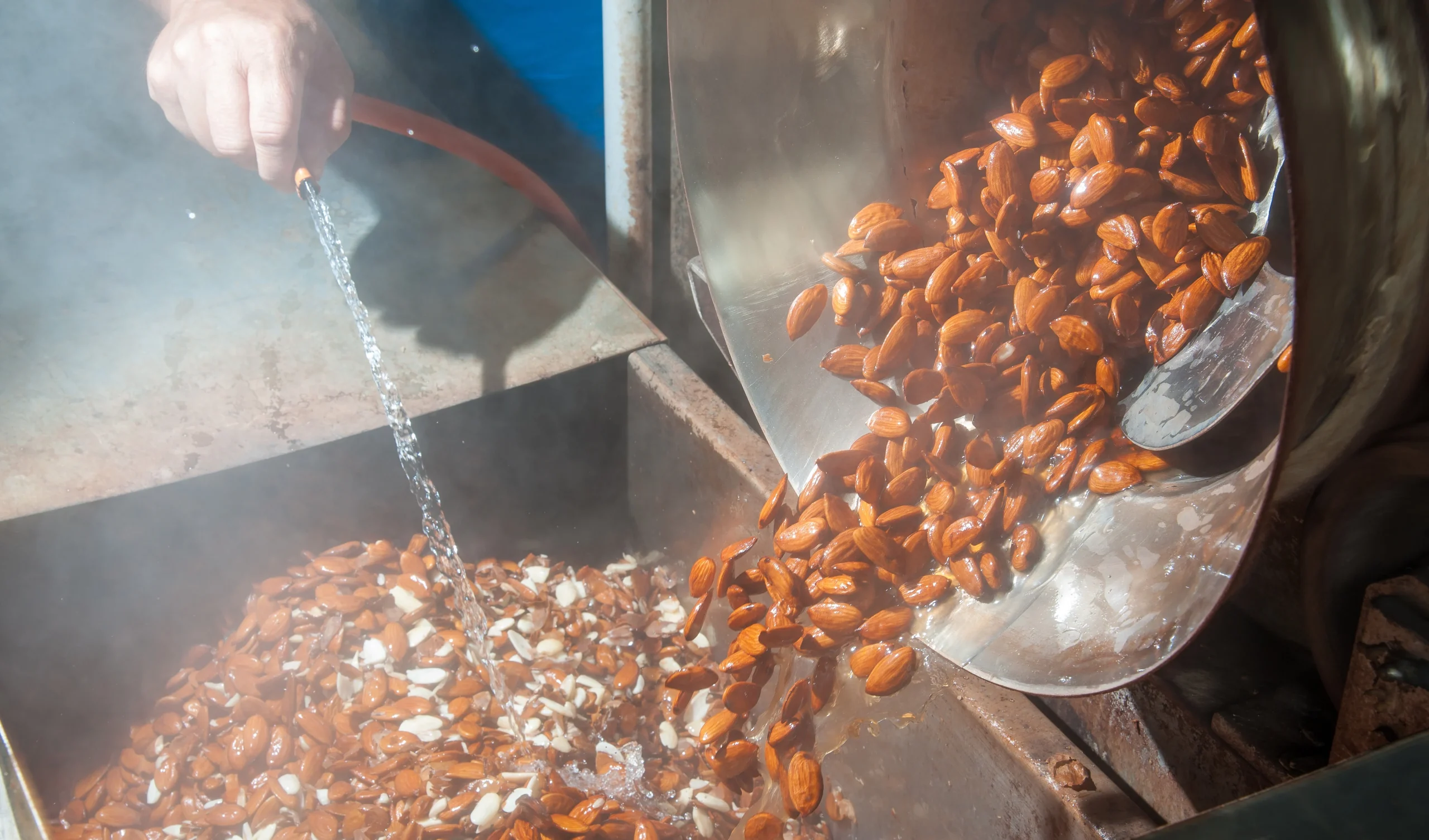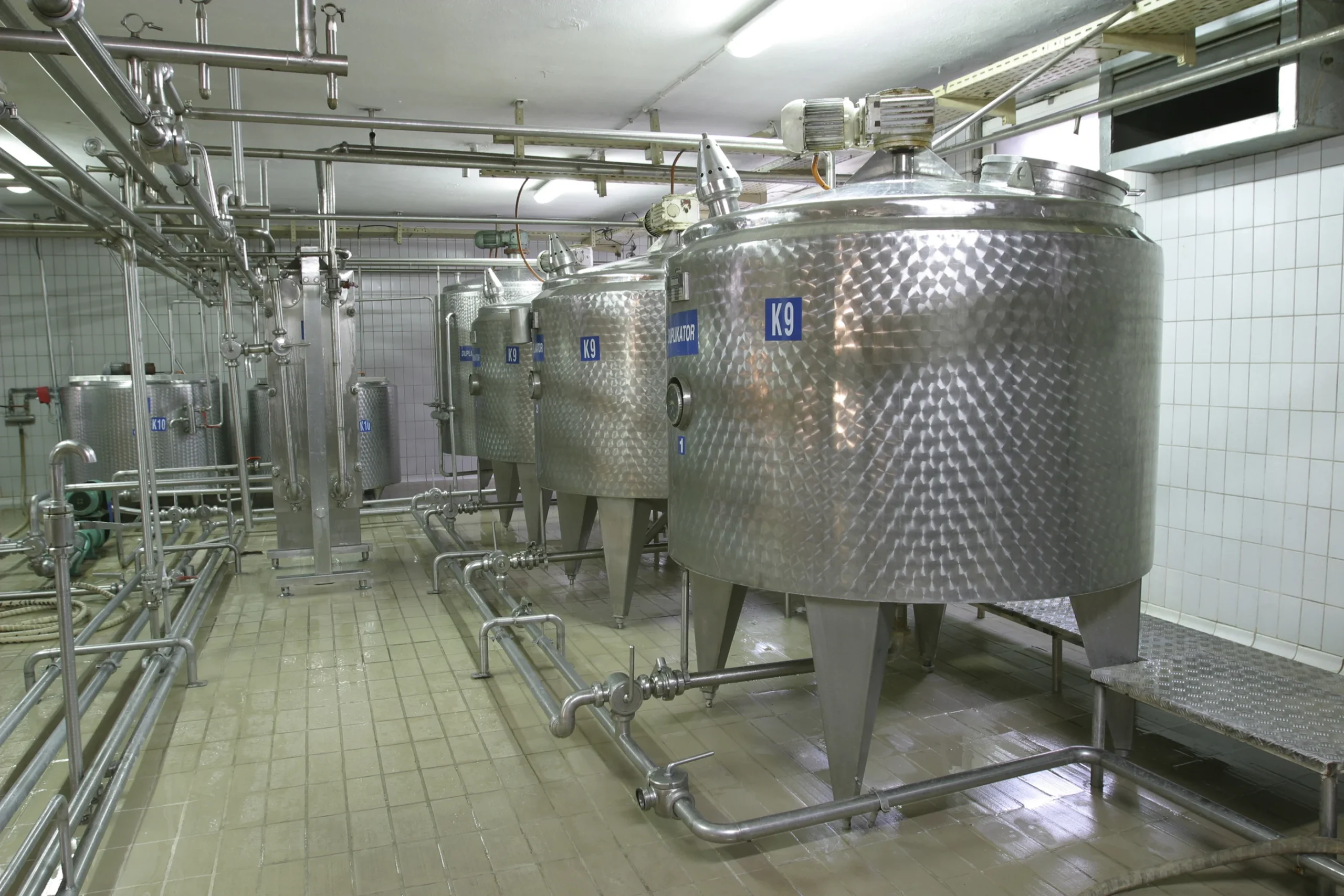The almond milk manufacturing industry demands precise process control to ensure consistent product quality, regulatory compliance, and operational efficiency. Each stage of this process requires multiple sensors, each with its own insertion point in the tank. Automation Products Group’s 3-A certified level sensors with integrated RTD consolidates two sensors into one solution that can be used throughout multiple stages of almond milk production.
To learn more about how our RP level probes are designed, and how they excel in a variety of tough applications, see Understanding the Versatility of RP Probes.
Almond Blanching
The blanching phase establishes a critical foundation for quality almond milk production, where maintaining optimal water levels and temperature control directly impacts almond hydration rates and final product yield. Our RPS sensor can handle both of those demands in one package.
The RPS uses a magnet within a mechanical float to actuate a series of reed switches within a probe stem. This provides a precise and continuous level measurement, monitoring real-time changes in water level above the almond bed.
Simultaneously, an RTD temperature sensor embedded in the bottom of the probe stem allows for precise temperature control of the soaking process, reducing the total blanching time without sacrificing the flavor and quality of the milk.

Blending and Homogenization
Once the blanching and grinding processes are completed, almond paste must be mixed with water, sweeteners, and nutritional additives before being pasteurized. This mixing process comes with challenges that many liquid level sensors cannot address.
The RPS provides solutions:
- Foam Interference – After thorough mixing, the surface of the almond mixture can create foam that interferes with some non-contact level sensors, such as ultrasonics. The RPS’s mechanical float sinks below the foam, providing an accurate level.
- Sticking – The RPS’s anti-stick float helps prevent the buildup of suspended particles and sticky liquids, minimizing issues that can impact sensor accuracy and create cleaning headaches.
- Cleaning and Maintenance – The Clean-Out-Of-Place (COP) design of the RPS makes maintenance and thorough cleaning easy. The integrated temperature sensor further reduces maintenance time by eliminating the need to service another sensor and another tank opening.
- Accuracy – The RPS delivers a high-resolution continuous level output with ±0.12 inch accuracy, which allows almond milk producers to achieve consistent blend ratios and higher quality control.
After blending and homogenization, almond milk goes through its pasteurization phase. Typically, this process is done at an extremely high temperature by running the product through holding tubes and heating the milk with tubular heat exchangers. Unfortunately, for many artisanal brands, the large and costly heat exchangers and holding tubes required for high temp pasteurization are out of reach. As an alternative, some choose batch pasteurization.
Batch Pasteurization
For those premium and artisanal brands that prioritize flavor and richness over quantity and shelf stability, batch pasteurization is a preferred technique. Batch pasteurization requires that almond milk be slowly heated in a tank to around 145° F for upwards of 30 minutes. Typically, this process uses temperature sensors at multiple locations in the tank to ensure proper heating throughout the mixture.
Here’s how the RPS makes batch pasteurization easier:
- Avoids Bottom Mount Tank Insertions – Sensor insertions in the bottom of a tank are hard to maintain because the tank must be completely emptied and cleaned before any maintenance can occur. The stem mounted RTD in the bottom inch of the RPS stem eliminates the need for a bottom mounted sensor.
- Clean-Out-of-Place (COP) Design – The RPS is optimized to make COP procedures easy for producers. The tri-clover sanitary tank connection can be easily removed, and the probe can be quickly pulled out for regular cleaning and tank maintenance.
Following pasteurization, the almond milk product is chilled for storage. From this point forward, cold chain compliance must be maintained and tracked. APG sensors can play a role in this process as well.

Inventory, Quality, and Compliance
The APG RPS sensor is a great fit for the refrigerated tanks used in almond milk storage.
Here’s Why:
- Precision tracking – ±0.12-inch resolution improves inventory accuracy.
- Flexible Configurations – Can be ordered to accommodate various tank heights and configurations.
- Supports Cold Chain Documentation – ± 1° C RTD accuracy helps ensure safe temperatures are maintained between production and bottling.
After the batch is chilled and bottled, sanitary standards require almond milk producers to clean and fully sterilize their production equipment. The chemicals stored for this process can be monitored using the RPS sensor as well.
Monitoring Clean in Place Chemicals
Maintaining sanitized equipment for almond milk production requires control of both chemical inventory levels and solution temperatures. For total microbial elimination, CIP systems use water, caustics, and acids heated as high as 190° F, which can create a challenging environment for many level sensors.
So how does the RPS manage those challenges?
- Corrosion Resistance – 304 and 316L stainless steels resist corrosion, even at higher temperatures, when exposed to appropriate concentrations of cleaning chemicals.
- High Temp Tolerance – The electronics within the RPS sensor are designed to handle up to 200° F, and can withstand repeated heating and cooling cycles.
- Temperature Control – The embedded RTD sensor can be used to control heating systems, ensuring that cleaning liquids are delivered at their most effective temperatures.
To learn more about potential measurement solutions for CIP systems, please see Level Sensors in CIP Systems: What Food Processors Need to Know.
Is the RPS a Fit for Your Almond Milk System?
The RPS Sanitary Series provides a convenient solution for almond milk producers seeking to consolidate level and temperature monitoring into a single, 3-A certified instrument. Still have questions about our RPS and how it would pair with your almond milk system? Contact the application experts at APG for help.
WRITTEN BY

Jason W.
Jason is APG’s Regional Sales Manager for the Midwest territory. With a strong focus on solving unique and challenging application needs, he partners closely with customers to deliver effective sensor solutions. Jason values integrity and reliability, and he brings these principles to every aspect of his work.


